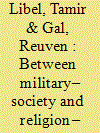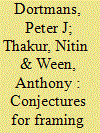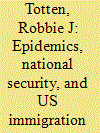|
|
|
Sort Order |
|
|
|
Items / Page
|
|
|
|
|
|
|
| Srl | Item |
| 1 |
ID:
140561


|
|
|
|
|
| Summary/Abstract |
The growing religiosity in the Israel Defense Forces (IDF) in recent years is discussed by employing the broader lens of changes to the organization's overall manpower. First, the authors will indicate the dynamic and changing make-up of those serving in the IDF, in terms of both the socio-demographic characteristics of conscripted soldiers, and the motivation of individuals enlisting in the IDF. Second, it is demonstrated how a window has opened in the IDF, especially in combat units and command roles, for a growth in religiosity as a result of the gradual increase in the number of conscripts affiliated with the Zionist national-religious population.
|
|
|
|
|
|
|
|
|
|
|
|
|
|
|
|
| 2 |
ID:
140555


|
|
|
|
|
| Summary/Abstract |
Cyberspace has emerged as a potentially new (and unconventional) domain for warfare. Much debate has focused on understanding cyber conflict. The ability to critically analyse this phenomenon is important; however, the nascent nature of cyberwarfare and the complexity of the systems involved create challenges not met by conventional approaches. As a first step, this requires an analytical construct to frame discussions in a way that highlights distinct characteristics of the cyber domain. An approach proposed is one of the postulating conjectures for debate as a way to achieve this and to demonstrate its use, both at the strategic and operational levels. It is suggested that such an approach provides one component of a mature analytical framework for the analysis of cyber across a range of warfare domains.
|
|
|
|
|
|
|
|
|
|
|
|
|
|
|
|
| 3 |
ID:
140558


|
|
|
|
|
| Summary/Abstract |
What are relationships between epidemics, national security, and US immigration policy? This question is important because it sheds light on transnational or nontraditional security areas, American immigration policy, and a pressing issue for US leaders who have recently faced epidemics such as the West Africa Ebola outbreak that began in 2013. This article answers it and lays ground in the area by reviewing epidemics in world history, using International Relations and Security Studies works to specify dangers of contagions for states, and identifying three general immigration measures that American leaders have utilized from the seventeenth century to the present day to protect against contagions, which are (1) policies restricting entrance of foreigners thought to carry specified diseases, (2) the isolation or quarantining of immigrants with contagious disease, and (3) delegating the President with authority to stop immigration in the event of an epidemic abroad. This study has implications for research and contemporary US immigration policy.
|
|
|
|
|
|
|
|
|
|
|
|
|
|
|
|
| 4 |
ID:
140563


|
|
|
|
|
| Summary/Abstract |
AirSea Battle (ASB) has generated significant publicity, controversy, and debate among scholars, analysts, commentators, and observers of US defense strategy. However, a research gap exists concerning formal analysis of the impact of the operational concept on the relationship between the US Air Force (USAF) and the US Navy (USN). The impact of the ASB operational concept on the USAF–USN relationship is examined across the issue areas of strategy, budgets, weapons procurement, and training. These four issue areas represent important areas of historical conflict and competition between the Air Force and Navy. The conclusion is that ASB is ushering in a new era of Air Force–Navy partnership that advances the inter-service dynamic from “jointness” toward integration. The emergent USAF–USN partnership therefore represents a significant development in US defense politics and defense strategy.
|
|
|
|
|
|
|
|
|
|
|
|
|
|
|
|
| 5 |
ID:
140564


|
|
|
|
|
| Summary/Abstract |
The extensive timespan of evolving assumptions about future adversaries, US military engagements, and technology inherent in the US Army's 30-year modernization strategy can overwhelm the management capacity of planners, and misdirect acquisition investments. Some military scholars have argued that long-range planning is futile due to the complexities of the global security environment. So how can the US Army manage the evolving assumptions inherent in its 30-year modernization strategy to ensure it remains a superior global force? This study will answer the above question by arguing that the US Army's 30-year modernization strategy, while emulative of a similar modernization approach in the threat-based planning environment of the Cold War, is viable if supported by a method and a tool that manage investments and planning assumptions.
|
|
|
|
|
|
|
|
|
|
|
|
|
|
|
|
| 6 |
ID:
140562


|
|
|
|
|
| Summary/Abstract |
This article examines Poland's national potential and its international position within the European Union (EU) with respect to security issues. It presents research results based on a comparison of Poland's national potential as it relates to other EU countries, which is useful when evaluating Poland's power within the EU. The article also evaluates Poland's crisis potential, i.e. it identifies those factors that may potentially be treated as threats to national and regional security. Finally, it enables the identification of challenges to Poland's security in the second decade of the twenty-first century. The research is conducted according to a multidimensional comparative analysis, which is perceived by the author as the best available to measure a country's power despite its weaknesses.
|
|
|
|
|
|
|
|
|
|
|
|
|
|
|
|
| 7 |
ID:
140556


|
|
|
|
|
| Summary/Abstract |
Up to the present, there is only very little research on how the population perceives terrorism and its threats, even though support from the population is crucial for effective counterterrorism. By eliciting beliefs and subjecting them to content analyses, six factors were found that determine the protection worthiness of a target in the people's view: the potential damage to “people,” “symbolism,” “economy,” “politics,” “nature,” and “image/publicity.” These empirically found factors are in line with factors specified by terrorist target selection models. They differ in the strength of their cognitive representation among participants and, thus, their subjective importance to the people. The first three factors are shared among all participants, whereas the latter ones could only be found in a part of the participant sample. People's judgments of the targets' protection worthiness differ substantially from their judgments of the targets' attractiveness to terrorists, even though the same factors seem to be involved. This study offers an insight into the people's mental model about protection worthiness of targets. Together with classical risk analysis and knowledge about terrorists, these results can form a basis for setting up a holistic scheme for critical infrastructure protection.
|
|
|
|
|
|
|
|
|
|
|
|
|
|
|
|
|
|
|
|
|